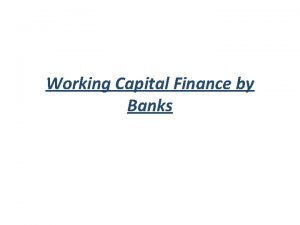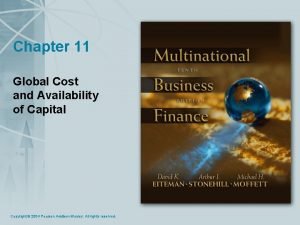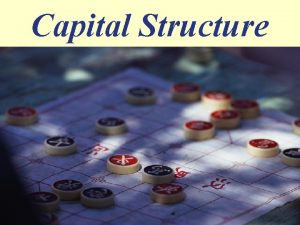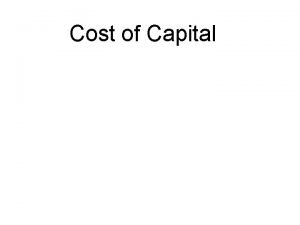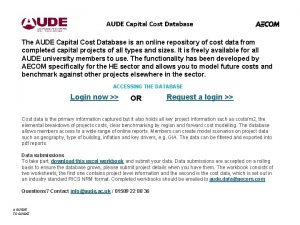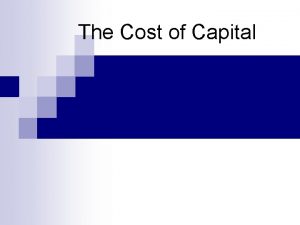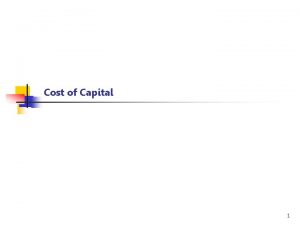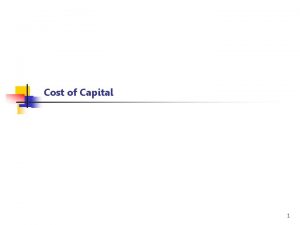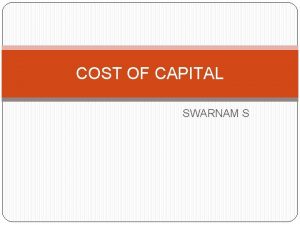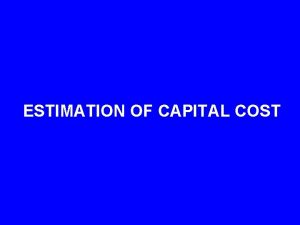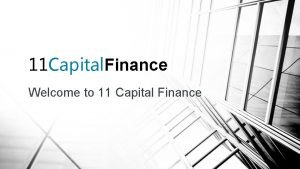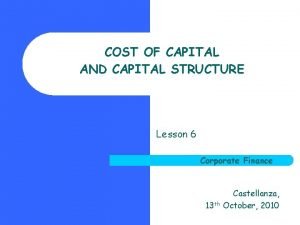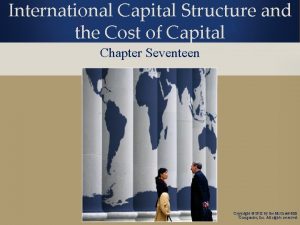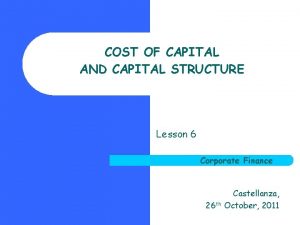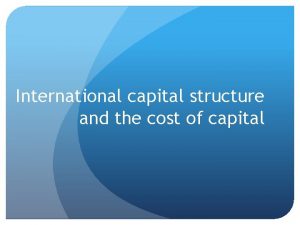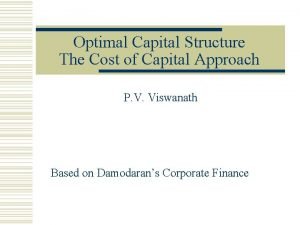FINANCE 12 Capital Structure and Cost of Capital


















- Slides: 18

FINANCE 12. Capital Structure and Cost of Capital Professor André Farber Solvay Business School Université Libre de Bruxelles Fall 2004 MBA 2004 Cost of capital

Risk and return and capital budgeting • Objectives for this session: – Beta of a portfolio – Beta and leverage – Weighted average cost of capital – Modigliani Miller 1958 MBA 2004 Cost of capital 2

Beta of a portfolio • Consider the following portfolio Stock Value Beta A n. A PA A B n. B PB B • The value of the portfolio is: V = n. A PA + n. A PB • The fractions invested in each stock are: Xi = ( ni Pi) / V for i = A, B • The beta of the portfolio is the weighted average of the betas of the individual stocks P = X A A + X B B MBA 2004 Cost of capital 3

Example • • Stock ATT Genetech V $ 3, 000 2, 000 5, 000 0. 76 1. 40 X 0. 60 0. 40 • P = 0. 60 * 0. 76 + 0. 40 * 1. 40 = 1. 02 MBA 2004 Cost of capital 4

Application 1: cost of capital for a division • Firm = collection of assets • Example: A company has two divisions • Value($ mio) • Electrical 100 0. 50 • Chemical 500 0. 90 • V 600 • firm = (100/600) * (0. 50) + (500/600) * 0. 90 = 0. 83 • • • Assume: rf = 5% r. M - rf = 6% Expected return on stocks: r = 5% + 6% 0. 83 = 9. 98 % An adequate hurdle rate for capital budgeting decisions ? No The firm should use required rate of returns based on project risks: Electricity : 5 + 6 0. 50 = 8% Chemical : 5 + 6 0. 90 = 10. 4% MBA 2004 Cost of capital 5

Application 2: leverage and beta • Consider an investor who borrows at the risk free rate to invest in the market portfolio • Assets $ X • Market portfolio 2, 000 1 2 • Risk-free rate -1, 000 0 -1 • V 1, 000 • P = 2 1 + (-1) 0 = 2 MBA 2004 Cost of capital 6

Expected Return P 20% 14% P M 14% 8% M 8% Sigma MBA 2004 Cost of capital 1 2 Beta 7

Cost of capital with debt • Up to now, the analysis has proceeded based on the assumption that investment decisions are independent of financing decisions. • Does • the value of a company change • the cost of capital change • if leverage changes ? MBA 2004 Cost of capital 8

An example • CAPM holds – Risk-free rate = 5%, Market risk premium = 6% • Consider an all-equity firm: • Market value V 100 • Beta 1 • Cost of capital 11% (=5% + 6% * 1) • Now consider borrowing 10 to buy back shares. • Why such a move? • Debt is cheaper than equity • Replacing equity with debt should reduce the average cost of financing • What will be the final impact • On the value of the company? (Equity + Debt)? • On the weighted average cost of capital (WACC)? MBA 2004 Cost of capital 9

Weighted Average Cost of Capital • An average of: • The cost of equity requity • The cost of debt rdebt • Weighted by their relative market values (E/V and D/V) • Note: V = E + D MBA 2004 Cost of capital 10

Modigliani Miller (1958) • Assume perfect capital markets: not taxes, no transaction costs • Proposition I: • The market value of any firm is independent of its capital structure: V = E+D = VU • Proposition II: • The weighted average cost of capital is independent of its capital structure rwacc = r. A • r. A is the cost of capital of an all equity firm MBA 2004 Cost of capital 11

Using MM 58 • • • Value of company: V = 100 Initial Equity 100 Debt 0 Total 100 Final 80 20 100 MM I • WACC = r. A 11% MM II • • 0 11% 100% 5% (assuming risk-free debt) 0. 20 12. 50% (to obtain rwacc = 11%) 80% Cost of debt D/V Cost of equity E/V MBA 2004 Cost of capital 12

Why is rwacc unchanged? • Consider someone owning a portfolio of all firm’s securities (debt and equity) with Xequity = E/V (80% in example ) and Xdebt = D/V (20%) • Expected return on portfolio = requity * Xequity + rdebt * Xdebt • This is equal to the WACC (see definition): rportoflio = rwacc • But she/he would, in fact, own a fraction of the company. The expected return would be equal to the expected return of the unlevered (all equity) firm rportoflio = r. A • The weighted average cost of capital is thus equal to the cost of capital of an all equity firm rwacc = r. A MBA 2004 Cost of capital 13

What are MM I and MM II related? • Assumption: perpetuities (to simplify the presentation) • For a levered companies, earnings before interest and taxes will be split between interest payments and dividends payments EBIT = Int + Div • Market value of equity: present value of future dividends discounted at the cost of equity E = Div / requity • Market value of debt: present value of future interest discounted at the cost of debt D = Int / rdebt MBA 2004 Cost of capital 14

Relationship between the value of company and WACC • From the definition of the WACC: rwacc * V = requity * E + rdebt * D • As requity * E = Div and rdebt * D = Int rwacc * V = EBIT / rwacc Market value of levered firm EBIT is independent of leverage If value of company varies with leverage, so does WACC in opposite direction MBA 2004 Cost of capital 15

MM II: another presentation • The equality rwacc = r. A can be written as: • Expected return on equity is an increasing function of leverage: requity 12. 5% 11% Additional cost due to leverage rwacc r. A 5% rdebt D/E 0. 25 MBA 2004 Cost of capital 16

Why does requity increases with leverage? • Because leverage increases the risk of equity. • To see this, back to the portfolio with both debt and equity. • Beta of portfolio: • But also: • So: portfolio = equity * Xequity + debt * Xdebt portfolio = Asset • or MBA 2004 Cost of capital 17

Back to example • Assume debt is riskless: MBA 2004 Cost of capital 18
 Multinational cost of capital and capital structure
Multinational cost of capital and capital structure Multinational cost of capital and capital structure
Multinational cost of capital and capital structure Cost accumulation and cost assignment
Cost accumulation and cost assignment Cost accumulation and cost assignment
Cost accumulation and cost assignment Cost pools
Cost pools What is a period cost on the income statement
What is a period cost on the income statement Cost control and cost reduction difference
Cost control and cost reduction difference Standard costing vs activity based costing
Standard costing vs activity based costing Distinguish between average cost and marginal cost
Distinguish between average cost and marginal cost Cost control and cost reduction difference
Cost control and cost reduction difference Job-order-costing-vs-process-costing
Job-order-costing-vs-process-costing Ordering cost and carrying cost
Ordering cost and carrying cost Opportunity costs and trade offs
Opportunity costs and trade offs Cost control and cost reduction project report
Cost control and cost reduction project report Cost control and cost reduction project report
Cost control and cost reduction project report Cost behavior and cost-volume-profit analysis
Cost behavior and cost-volume-profit analysis Mpbf method
Mpbf method Global cost of capital
Global cost of capital Working capital management refers to
Working capital management refers to
















